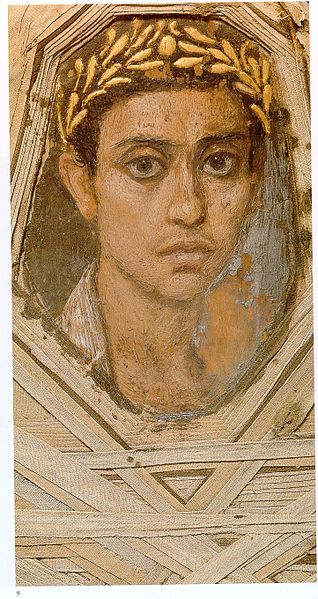Mummy portraits or Fayum mummy portraits are a type of naturalistic painted portrait on wooden boards attached to upper class mummies from Roman Egypt. They belong to the tradition of panel painting, one of the most highly regarded forms of art in the Classical world. The Fayum portraits are the only large body of art from that tradition to have survived. They were formerly, and incorrectly, called Coptic portraits.
Mummy portrait of a young woman, Antinoöpolis, Middle Egypt, 2nd century, Louvre, Paris.
This heavily gilt portrait was found in Antinoöpolis in winter 1905/06 by French Archaeologist Alfred Gayet and sold to the Egyptian Museum of Berlin in 1907.
Detail of a portrait within its mummy wrappings, Metropolitan Museum of Art, discovered by Flinders Petrie in 1911.
Mummy portrait of a man from Fayum. Encaustic on limewood, AD 80–100. British Museum
A portrait is a painting, photograph, sculpture, or other artistic representation of a person, in which the face not always is predominant. In arts portrait can be represented as half body and even full body. If the subject in full body better represents personality and mood - this type of presentation can be chosen. The intent is to display the likeness, personality, and even the mood of the person. For this reason, in photography a portrait is generally not a snapshot, but a composed image of a person in a still position. A portrait often shows a person looking directly at the painter or photographer, to most successfully engage the subject with the viewer, but portrait can be represented as a profile and 3/4. It’s important to understand that a subject with eyes closed also can be tractate as a portrait.

Portrait of an Achaemenid Satrap of Asia Minor (the Herakleia head, from Heraclea, in Bithynia), end of 6th century BCE. This is an Eastern portrait in purely East Greek Archaic style, one of the two known forerunners of extant Greek portraits, along with the Sabouroff head.
A Roman bust of the Athenian General Themistocles, based on a Greek original. The lost original of this bust, dated c. 470 BCE, has been described as "the first true portrait of an individual European".
The Mona Lisa, a painting by Leonardo da Vinci of Lisa Gherardini, is the world's most famous portrait.
Plastered skull, Tell es-Sultan, Jericho, Pre-Pottery Neolithic B, c. 9000 BC








